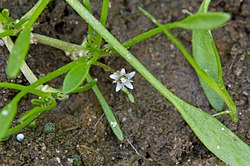| Limosella aquatica | |
|---|---|
 | |
| Scientific classification | |
| Kingdom: | Plantae |
| Clade: | Tracheophytes |
| Clade: | Angiosperms |
| Clade: | Eudicots |
| Clade: | Asterids |
| Order: | Lamiales |
| Family: | Scrophulariaceae |
| Genus: | Limosella |
| Species: | L. aquatica |
| Binomial name | |
| Limosella aquatica L. (1753) | |
| Varieties [2] | |
| |
| Synonyms [2] | |
Plantaginella aquatica(L.) Moench (1794) | |

Limosella aquatica is a widespread species of flowering plant in the figwort family known by the common name water mudwort. It is native to much of the temperate world, where it grows in many types of wet habitat. It is semiaquatic, growing in moist land habitat such as meadows, in mud and wet sand next to water, and partly submersed or floating in the water. It is a fleshy annual herb forming low tufts in muddy substrate. The leaf is made up of a petiole up to 30 centimetres (12 in) long but usually quite a bit shorter, tipped with a flat spoon-shaped blade up to 3 cm (1.2 in) long. The inflorescence is an erect stalk bearing one tiny white to pink- or blue-tinted flower about 2 millimetres (0.08 in) wide. The fruit is a capsule up to 5 mm (0.20 in) wide containing many tiny seeds.
